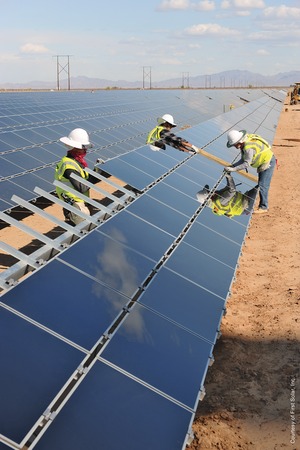
A new $300-million solar-panel factory sits just outside Mesa, Ariz., waiting to be sold for a $50-million loss. Never used by Tempe-based First Solar, the plant is symbolic of how solar-panel manufacturing has been hit hard by Chinese overproduction. Other solar plants have been mothballed, and General Electric has scrapped plans for a major Aurora, Colo., production facility.
Things could be looking up for U.S. manufacturers, however, as China, the global production leader, recently announced a ban on new capacity. "Because solar components were so cheap in China, not only the manufacturers but the entire supply chain set up shop there," says Daniel Holland, an equity analyst for Morningstar, Chicago. "This made it very hard for new entrants and new facilities here in the United States."
The capacity glut has forced construction firms to refocus. M+W Group, a Germany-based construction conglomerate that built the 1.3-million-sq-ft First Solar site in Mesa, says that while solar remains a major driver, the company has switched from upstream manufacturing to downstream powerplants.
"The Chinese invested so heavily in solar-manufacturing capacity that it drove a lot of players out of business," says James Ellington, M+W's U.S. executive vice president for advanced infrastructure technologies. "The incentives and demand for utility-scale powerplants is much stronger at the moment than the need for increased manufacturing capacity of cells and panels." The hope is that, in the next year to 18 months, market dynamics will return to "fairness in global competition" and that manufacturing capacity will experience a resurgence, Ellington tells ENR.
The rapid drop in prices also has increased sales and general interest in solar panels and provided buyers with good access to those materials, Holland notes. If a ban remains on new Chinese capacity, U.S. support of renewable energy might be favorable to those secondary suppliers looking for their next market. "Other markets, where there is a need for more of a supply chain, might start looking attractive, but that also creates the potential for a glut in capacity," he says. "It's a very nuanced subject."
Going forward, costs will continue to drive the market, M+W says, advising other construction and engineering firms to design and build facilities that help manufacturers drive down the per-watt cost of producing solar panels. "These are usually large, technical facilities, [which are] very challenging in terms of their physical complexities and needing hundreds of different subcontractors," Ellington says. When asked if M+W had been paid for its work on First Solar's Mesa facility, he adds, "Out of respect for the client, I have no comment on that."

Post a comment to this article
Report Abusive Comment